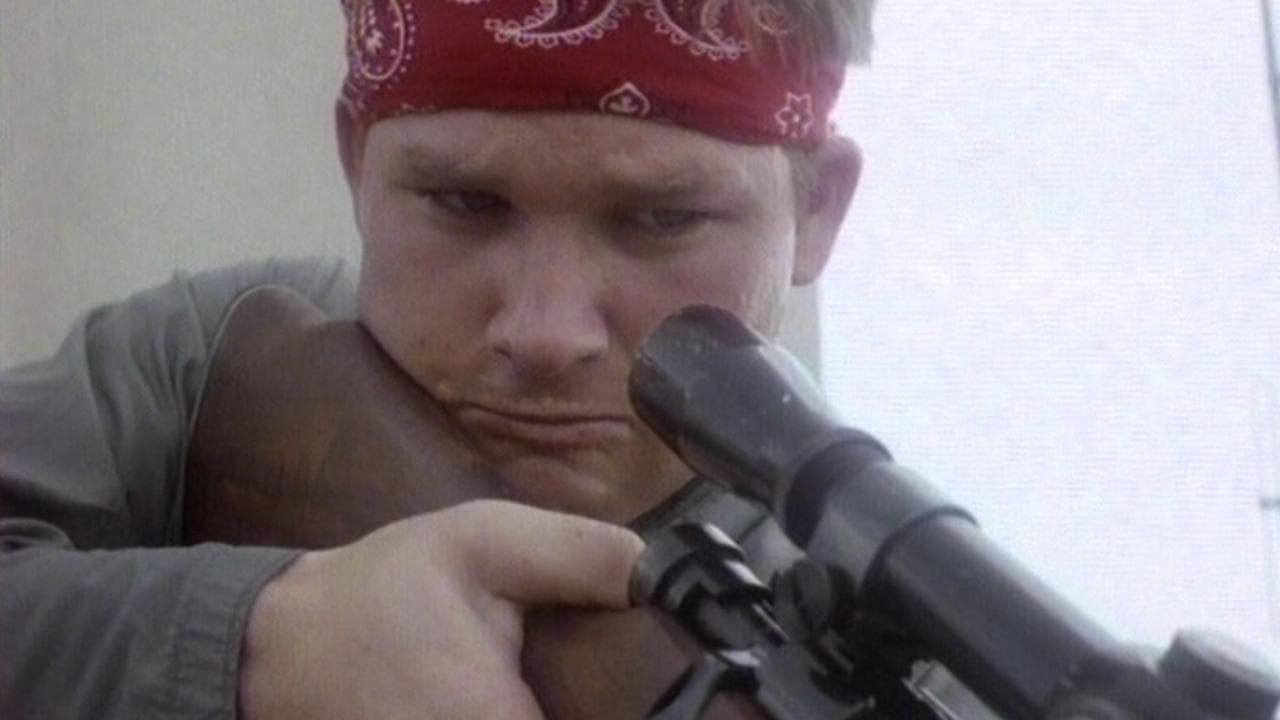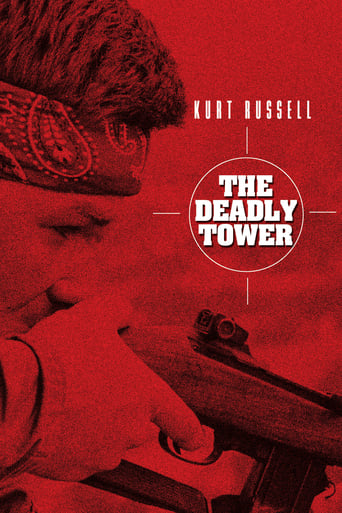

"Airport '77" director Jerry Jameson's methodical reenactment of Charles Whitman's infamous sniper spree in Austin, Texas, back in 1966, that left sixteen citizens dead and another 32 wounded provided affable Disney star Kurt Russell his first major dramatic role. You've never seen Russell like he is here, and his performance is notably taciturn. Before he climbed atop the tower at the University of Austin campus, Whitman stabbed his mother as well as his wife to death. As usual for a Hollywood made-for-television feature, scenarist William Douglas Lansford and writer Antonio Calderón have played fast and loose with the facts. Hispanic Austin Policeman, Ramiro Martinez (Richard Yniguez of "Cancel My Reservation"), was one of the cops who ultimately stormed the tower and killed Whitman. Actually, none of Martinez's bullets killed Whitman. Nevertheless, in the name of political correctness and diversity, the producers probably appropriated his ethnicity to make things compelling. Interestingly enough, by the time that Whitman started blasting away at random targets, an army of private citizens armed with their own rifles turned out in numbers to retaliate with their own hailstorm of bullets. Meantime, Whitman did not discriminate in his choice of targets, but Jameson couldn't depict this murderer in too harsh a light since "The Deadly Tower" was a made-for-television movie. For example, Whitman pulls a knife on his mother and wife, but Jameson doesn't show this psycho carving either woman up. Indeed, he doesn't lay a finger on his cute little puppy. Jameson cross-cuts between Whitman and Martinez. The day that Whitman launched his one-man massacre, Martinez had learned grudgingly that the department refused to promote him to the rank of sergeant. John Forsythe, Pernell Roberts, and Clifton James play Austin cops in supporting roles as everybody mobilizes for the situation. Jameson maintains tension, suspense, and atmosphere throughout this competently made, 92-minute, crime thriller without resorting to obligatory blood and gore. Furthermore, he doesn't let an abundance of plot hinder the action. Russell is particularly outstanding because he had never played such a homicidal hellion. In real life, Whitman wore sneakers, while the producers showed our protagonist polishing his Marine boots with fetish-like appreciation. Quite possibly, the producers added this fascination with boot leather because the sniper that Andrew Robinson played in the theatrical feature "Dirty Harry" wore paratrooper jump boots and kept them gleaming. Of course, Jameson and his writers take the opportunity to slip in some anti-gun rhetoric. As far as made-for-television movies rate, "The Deadly Tower" qualifies as one of the best despite some of its anti-gun propaganda.
... View MoreDramatization of horrific events out of Austin, Texas in August 1966 when disturbed young man Charles Whitman went on a shooting rampage from the tower overlooking the university. Well-written TV-movie (cast with familiar television actors in supporting roles, and Disney mainstay Kurt Russell effectively playing against type in the lead), is anything but entertaining; however, the approach here--tough and unrelenting--provides for a fascinating docudrama. Crossing the paths of Whitman and local police officer Ramiro Martinez (nicely-played by Richard Yniguez) gives the narrative its drive, though the real-life Martinez was unhappy with his portrayal and sued. Liberties were indeed taken for 'dramatic purposes,' yet the hard-hitting film is still memorable today for its no-nonsense handling, the realistic violence and taut characterizations.
... View MoreI saw this movie when it first aired in October 1975. NBC ran a viewer advisory that it was very intense and may affect sensitive viewers. Yes, indeed! Whitman was one demented person and the casting of All-American Disney actor Kurt Russell to play him was incredible...it showed Russell could do heavy stuff. The casting of journeyman Latino actor Richard Yniguez to play Officer Martinez was also great. The supporting cast (Ned Beatty, John Forsythe, Pernell Roberts, etc.) was also excellent. It was interesting to see Mr. Forsythe as a detective investigating the gun stores-a far cry from Bentley Gregg or Blake Carrington. This was also Pernell Roberts' first time on TV in a while playing Martinez' sergeant. Part of the intensity of the movie came from the fact that Whitman shot at anyone or anything that moved and any attempt to take him out (shooting from a plane or citizens shooting with their hunting rifles) only agitated him. The bookstore clerk guiding Martinez and his fellow officers into the tower showed true heroism. I was in college in California when this movie first aired and I mentioned to my father that my college's library had an observation/study deck that somebody could use for such an act! In fact the college security department worked out a plan in case of somebody doing this. Thank goodness nobody tried this. Back to the movie...it was presented from Martinez' point of view and some have said there is a Latino bias, but I say it is a very intense depiction of true heroism. 43 years have passed since that tragic day. One would hope it would never happen again anywhere, but it does (Fort Hood, San Ysidro, Orlando, to name a few).
... View MoreI first saw this film on TV (late-night) about 8 years ago. It intrigued me to do some research. I found Gary Lagergne's book "A Sniper in the Tower" and read it. Whitman (Russell) was much the brooding silent tortured man as portrayed, but had a very violent streak and seemed to be amused by other peoples' pain. The film does seem to support the 'brain tumor' theory, but it doesn't touch any of Whitman's life. He was raised by a very rich and dominating, physically abusive father who loved guns and demanded obedience and success from his sons. Charles never knew what compassion and love were, but for achievement and abuse. He had to be the best at everything. He was the youngest EVER to become an Eagle scout, at age 12. He joined the Marines as a way of escaping his father's abuse and control. The Corps did, for a time, keep him in line, but when he attempted to get a degree at UT Austin in 1964 he was out of their control and failed to reach the standard they demanded. Then came his marriage and more problems. He was ambitious but not able to achieve anything. Failed jobs, a court-martial, getting out of the Corps he now hated, and a failed attempt at an engineering degree again at UT Austin caused him great anguish and depression. Above all, he was financially dependent on a father he hated. This couldn't have helped his self-respect. When Whitman killed his wife, mother and dog, and went into the University Tower on August 1, 1966, he was plagued with headaches, anger and severe depression. The film, with the never-happened 'airplane' sequence, and the compassionate detective (Forsythe) who tries to find out his name is overly dramatic and complicated. The 90-minute siege on the tower, finally ended by Martinez, Crumm and Foss was dramatic enough. Technically, it's accurate enough, despite being filmed in Baton Rouge LA since Austin didn't want to let the UT tower be used. But the amount of gunfire Whitman is loosing from the tower is beyond belief. He's using, early on, a bolt-action rifle. Time between shots as he pulls and cycles the bolt is at least 2 seconds. Yet as people below are running for cover, you hear shots like from a semi-automatic rifle. It hurts what needed to be simple, more stark and horrible, not a hail of bullets raining down from above. So as in my other comments, Hollywood doesn't always get it right, even though they can tell the authentic story and do it well, if they trusted the intelligence of their viewers. But when was that ever the case?
... View More